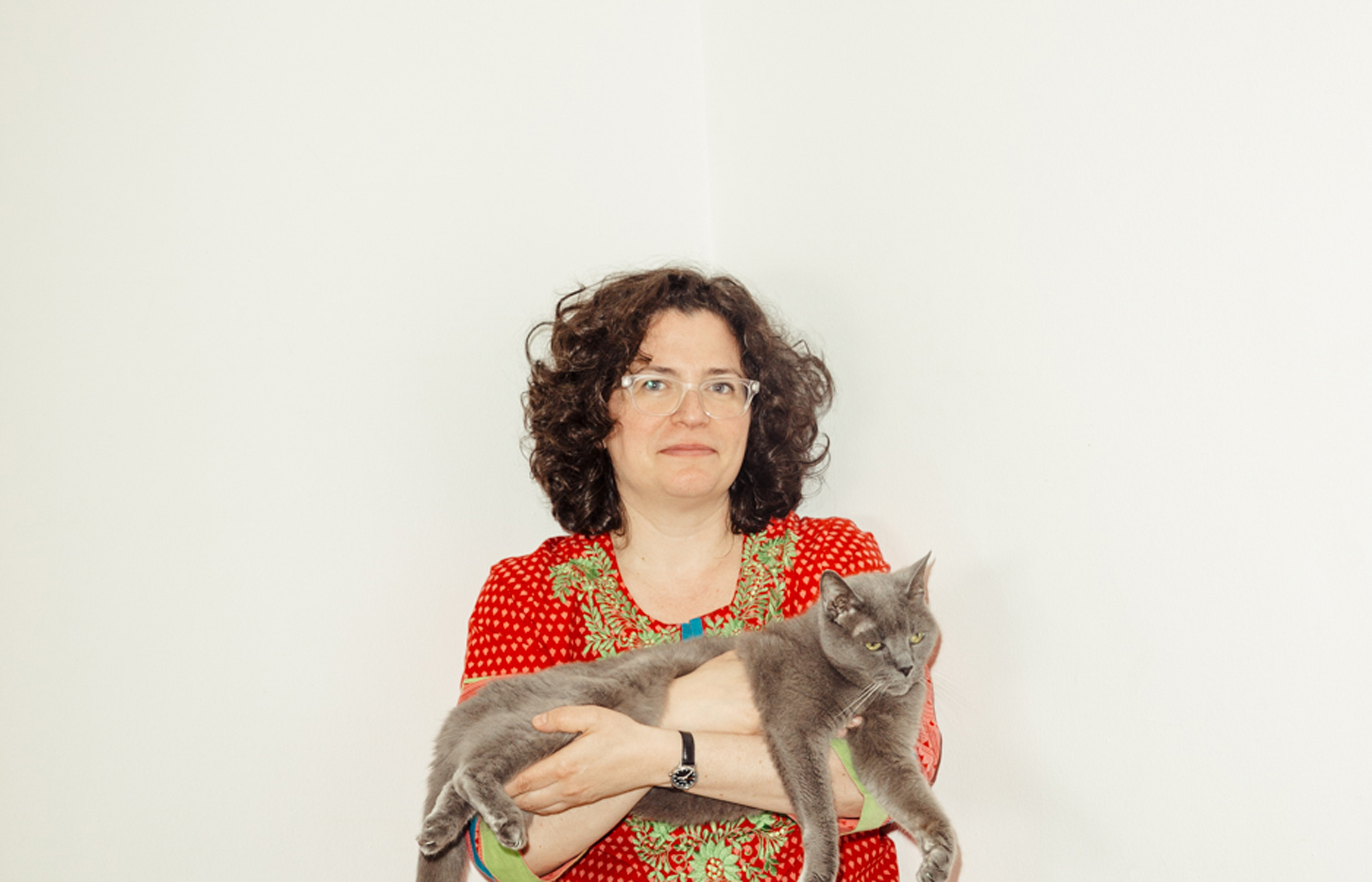
Amy Cutler
No Frills
Interview by Kristin Farr // Portrait by Nathan Perkel
Amy Cutler relates her work to a low whisper, yet the sentiments should be heard loudly. In her secret world, salt-of-the-earth women work hard, solemnly powering through their fantastical chores with thankless determination. They are an amalgamation of folk traditions, illustrating contemporary experience through the lens of myriad cultural sources researched and experienced by the artist. She is a constant observer, collecting visual identities for her own studio alchemy where the witching hour is prime for her stories to ripen and unfold.
Kristin Farr: What are your current fascinations?
Amy Cutler: Opium dens and volcanos are two things that hold my interest right now. I’m interested in exploring ideas of the suspended state of numbness and the tension of eruption—very related somehow.
What’s the first thing you would do if you woke up among the women you’ve been painting?
I would change my clothes so that I wouldn’t stand out. They have a subtle dress code, and my contemporary clothes would be off-putting. I have a suspicion that they wouldn’t be too welcoming. What does this mean to not be welcomed in a world I created? I might need to rethink things.
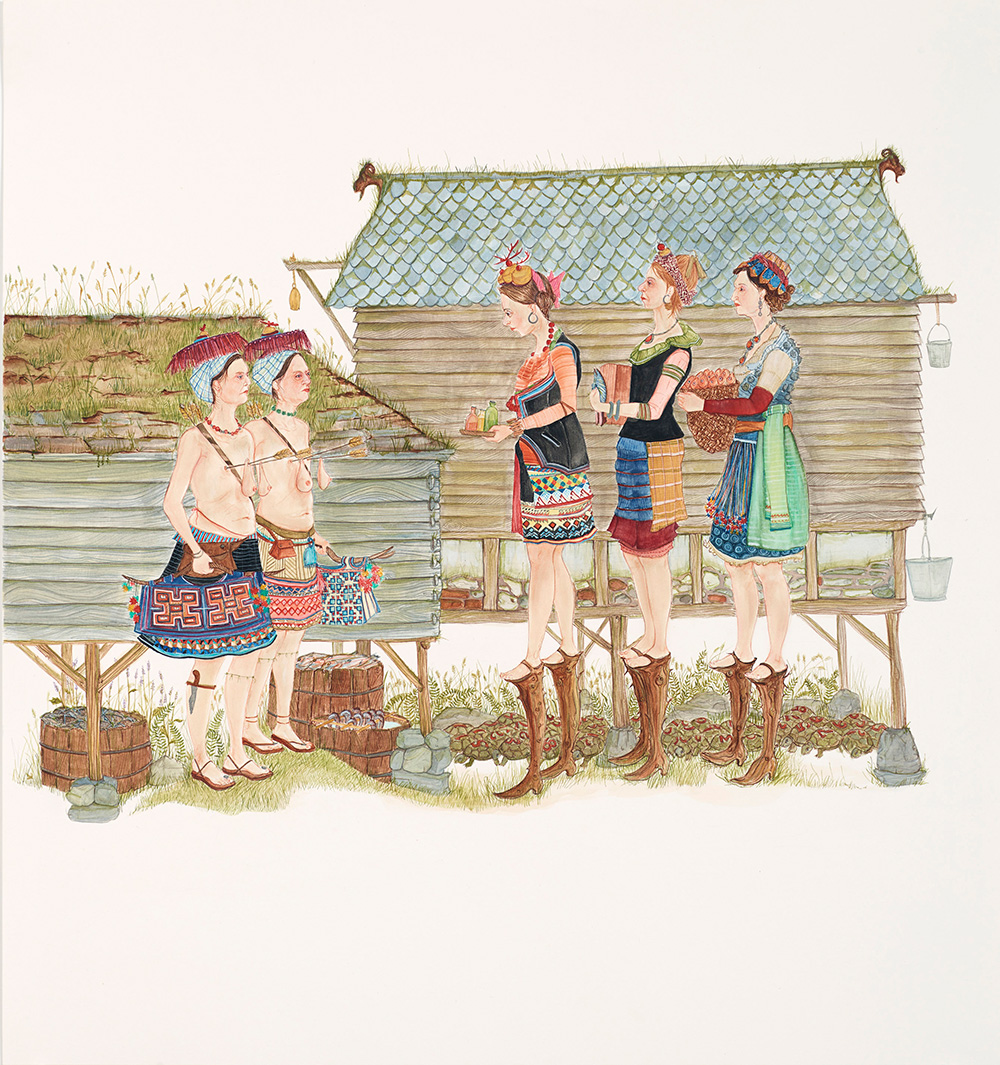
What would their colony be called? What is their shared purpose?
They would not see themselves as a colony but as the only existing group of humans. There would be a large network, which means they would not be isolated. Maybe they would describe individual groups by region. Their shared purpose is working towards a self-sustainable utopia where there is no need for war. Pretty much the model for every dystopia. Ego always gets in the way.
What do they eat?
No processed food or fad diets for sure. Chocolate would be their main indulgence.
Saddleback is a great representation of how hard we can make things for ourselves. The humor and metaphors in your work often feel like a sisterly wink and nod about the female experience. Why are you drawn to the metaphorical layers?
A lot of my work is mined from older sketchbooks. I need ideas to ferment. Ideas seem to reach their peak ripeness at about five years. Through that distance in time, I’m able to gain perspective on my own personal experiences. This is where the layering of metaphors often enters. There is always something current that I am investigating, but it is connected to something in the past. Humor makes the scenario easier to digest. If the work was super serious and direct, it would be quite depressing and unenjoyable to make. There must be room for interpretation so that my stories are not restricted to my personal inspirations only. My hope is that they have a life of their own. An advantage to creating opened stories is that people often fill in the details with their own experiences. This is when the work starts giving back. My work is very personal, and people often offer up very personal interpretations, which are very revealing. The interpretations of the work seem more fluid
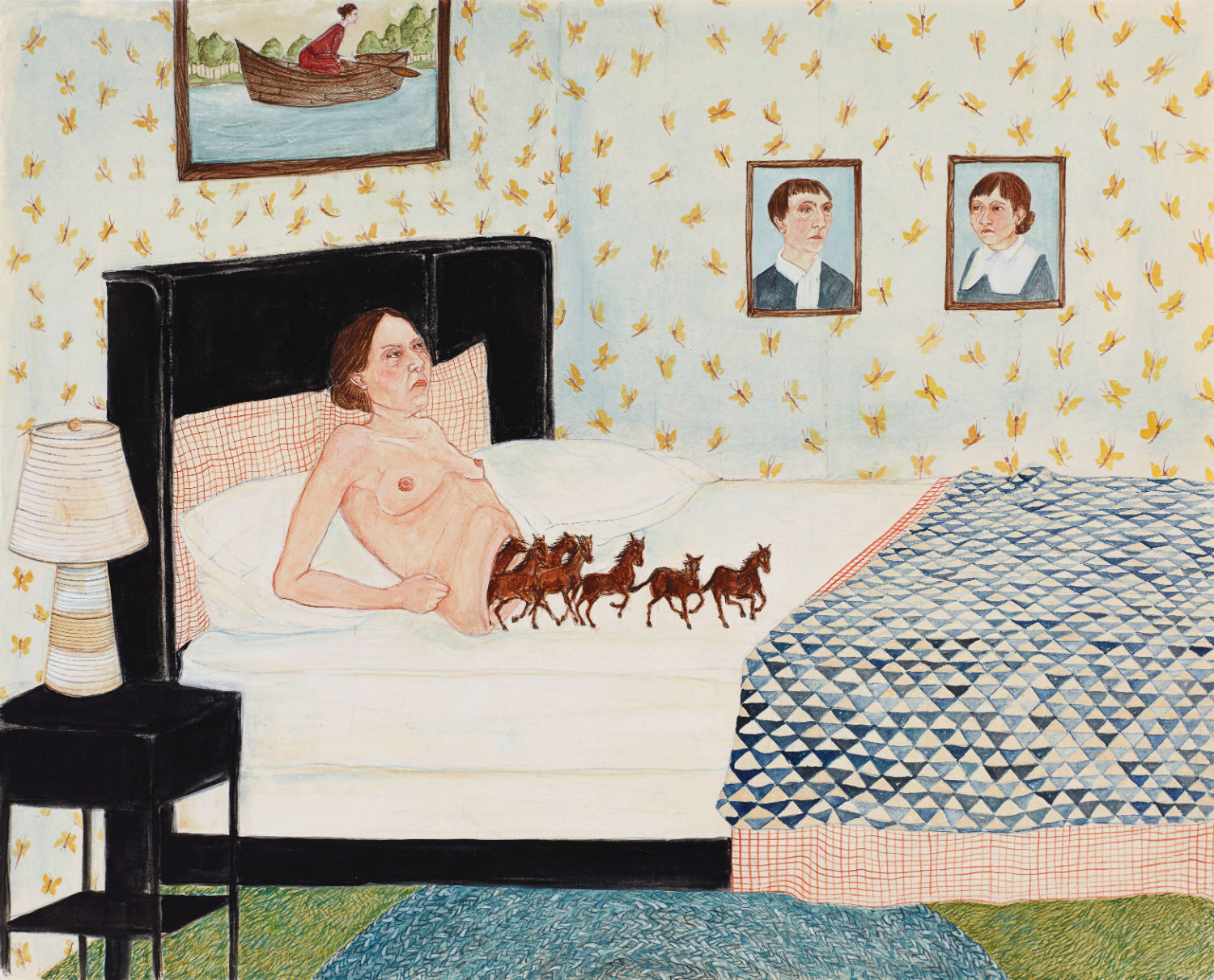
What’s an example of a metaphor for a personal experience that has shown up in your paintings?Birds have always represented the migration of thoughts, and often those birds congregate inside a head—the head being the home of thoughts. I recently made a series of heads that open up like medicine cabinets. All the contents are revealed on shelves. This comes from the need to prioritize and organize. I think a lot of my anxiety is fueled by chaos and indecision.
You Were Always on My Mind is about the memory of faces and the acknowledgement that our thoughts are made up by the influence of many other people’s ideas. There are many disembodied hands and eyes displayed in the background, and they make reference to a recurring dream I’ve had about misplacing both.
What are some other personal secrets you’ve revealed in a veiled way?
My last installation, Fossa, which is a collaboration with musician Emily Wells and hair stylist Adriana Papaleo, explored burden. I often express burden by physical weight or tension. Hair was the most prominent element in the installation—over 900 feet of braided hair. Hair reveals so much about a person’s identity. It also holds the most basic genetic information about a person’s DNA, which links them to their past and their current health. Fabric bundles or hobo sacks are also prevalent in my work and function as a symbol of transition while concealing or protecting something.
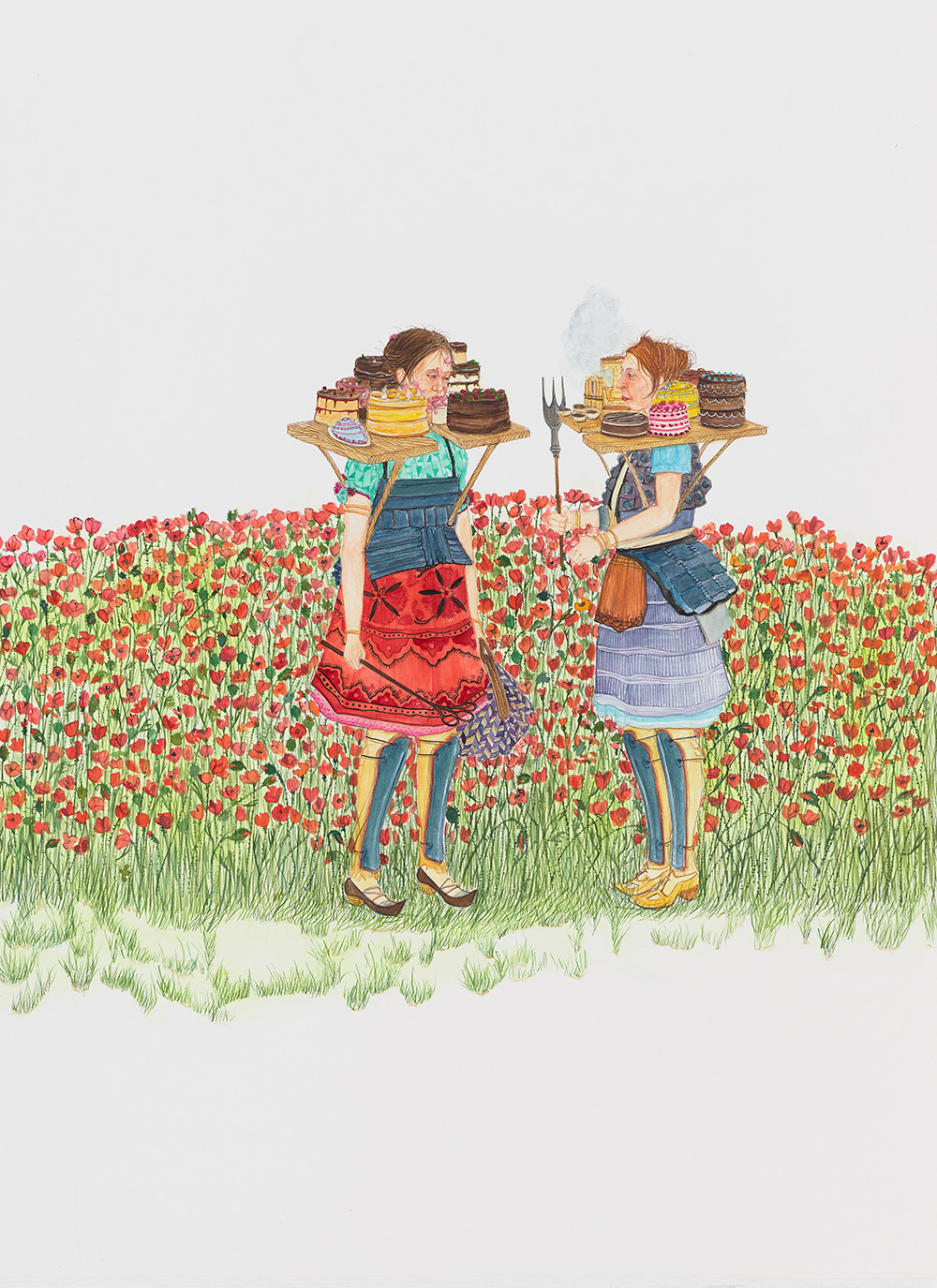
Tell me more about the hair.
I used hair i as a conduit of sound. I created a “legend” drawing, which shows a community of women that grow and groom their hair to use it as the primary resource in their self-sufficient community. It is aligned with an agrarian society, but removes the need for both plants and animals. I’m fascinated by communities of self-sustaining organizations. I’ve looked at many nineteenth-century photographs of logging communities. These images are so compelling and relate so much to other infrastructures found in nature—micro and macro views of our world. Maybe that is why many images from the time of the industrial revolution captivate me. The physical mechanisms are exposed and have many parallels to things humans have no control over.
Have you seen Mika Rottenberg’s Cheese video installation, with the long-haired sisters?
Amazing! I love all of her work, but seeing Cheese at the Whitney Biennial blew my mind. I definitely felt a kinship to that piece.
Me too! It was a decade ago but it really stuck with me. Your work has a mash-up of influences, Eastern and Western, contemporary and historic. What juxtapositions do you find yourself working with most often?
As an American with no strong ties to any ancestral traditions, I am curious about other cultures, and I’m drawn to working with pre-industrial imagery because of the poetic nature of the exposed mechanics. The clothing and architecture are made by hand. Nothing is hidden in the process.
I think a lot about climate change and globalization. This is where the mash-ups are justified. I live in a part of Brooklyn that has a large Bengali population. Jackfruit is always available. Just seeing this large fruit inspires so many thoughts.
What is some of your other prominent source material?
Memories, misunderstandings and anxiety are the most immediate source material. I write down things that pique my interest and do some research that usually leads me in different directions. I work from my imagination, but will refer to images or objects for details. Sometimes I will watch films or research images online. I do a lot of people-watching. The city and traveling has had huge influence on my work.
I’m always hunting for different features. I become obsessed with certain details like the curve of a neck or the length of the exposed part of the septum. These things reappear in my work often. An excellent place to “shop” for features is on the subway. Sometimes, if I spend extended amount of time with someone, they will pop up in my work unexpectedly.
Sometimes I can just walk into a local foreign foods store for inspiration. There are so many things that are interesting and spark strange narratives. The pickled goods aisle is always fascinating. I live on the tenth floor, and my neighbor who lives in a two-story, free-standing house was building a free-standing bathroom in the middle of the small, paved backyard. This is curious and could become source material.
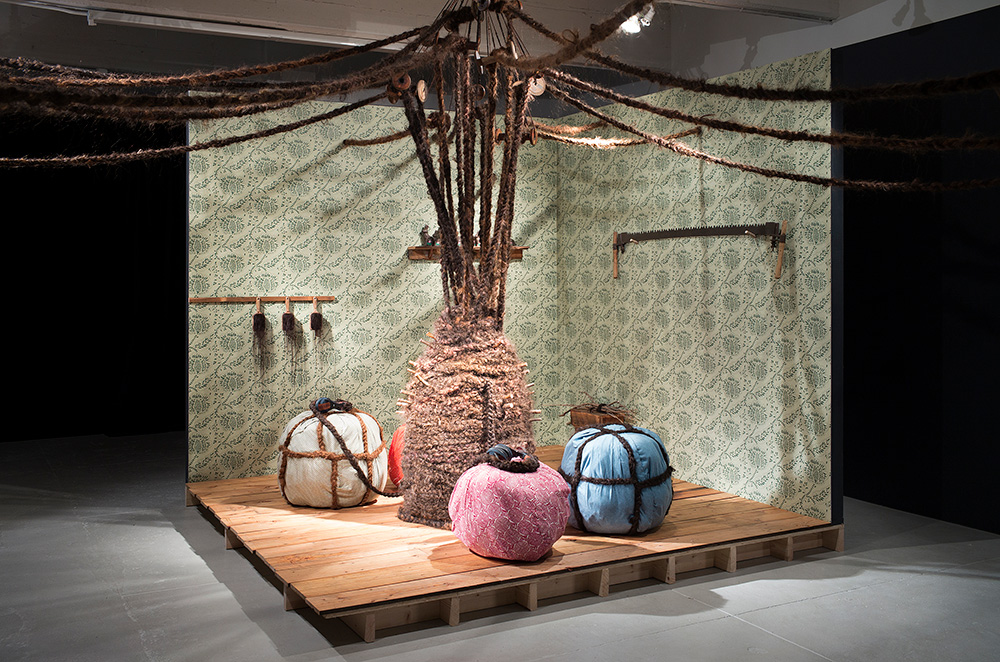
Do you feel like making art can be an out-of-body experience?
There are moments of clarity and instinct that feel uninhibited by time. These moments often come late at night, when I always tell myself not to overthink things. I guess it’s referred to as “being in the zone.”
How do the personalities of your characters get revealed to you?
My favorite part of starting a new piece is always painting or drawing the face of the person or animal. I’m certain their expressions are a direct reflection of my current mood. The face always leads the way to the posture, costume and ornamentation. It’s a dance. Sometimes the work will hang on my studio wall as floating heads until I can imagine what each character is trying to express.
What are your favorite textiles and what is their significance in your work?
I have always worked with the figure and dressed them. It was very limiting to work from my imagination when it came to textiles. Everything was stripes and dots. I looked through a batik book in the early ’90s and was forever changed. A whole new world opened up to me. My palette exploded, and different cultures became very prominent in my work. Through textiles, I brought my characters into different terrains and explored many hybrid scenarios. I focused on ceremonial dress and traditional costumes. And I’ve created a variety of subtexts. It became another layer of the story. There are so many cross-cultural connections found in textiles because they travel on the backs of people as they migrate. They are loaded with history.
I’ve worked with Japanese textiles a lot. I’m drawn to the themes and adaptability. I took a Shibori class a few years ago to get a better grasp on how some of the patterns are made. It’s a very interesting process.
What are your favorite textiles and what is their significance in your work?
I have always worked with the figure and dressed them. It was very limiting to work from my imagination when it came to textiles. Everything was stripes and dots. I looked through a batik book in the early ’90s and was forever changed. A whole new world opened up to me. My palette exploded, and different cultures became very prominent in my work. Through textiles, I brought my characters into different terrains and explored many hybrid scenarios. I focused on ceremonial dress and traditional costumes. And I’ve created a variety of subtexts. It became another layer of the story. There are so many cross-cultural connections found in textiles because they travel on the backs of people as they migrate. They are loaded with history.
I’ve worked with Japanese textiles a lot. I’m drawn to the themes and adaptability. I took a Shibori class a few years ago to get a better grasp on how some of the patterns are made. It’s a very interesting process.
I know Persian miniature painting is also an interest of yours. What do you like about it?
Persian miniatures are like little time capsules. They’re made for an audience of one, and they only reveal themselves when you stand close enough to see everything. I’m intrigued by the scale and their sense of time and twisted perspective. Their vibrancy and detail are captivating.
Have you painted murals?
I would love to design a mural, but the feat of actually painting one terrifies me. I’m in awe of artists who can translate an image into such an enormous size. Public art is an important part of society and it seems like what I do is completely opposite. The idea is very intriguing, though over-editing to appeal to the committees involved must be hard. Murals are broadcasts, and my work is more of a low whisper. I enjoy challenges that take me out of my comfort zone, so I would not turn down the opportunity.
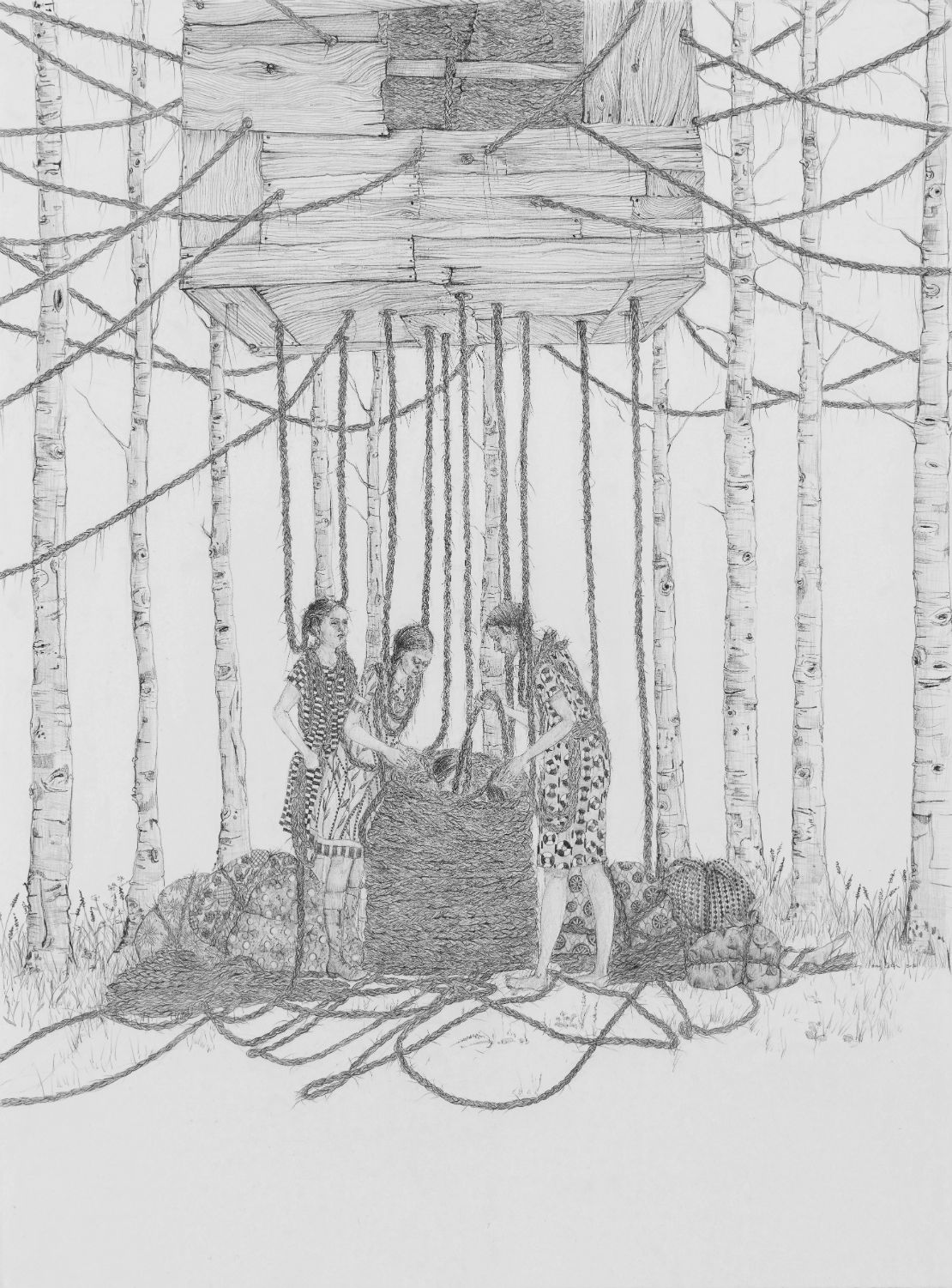
What are some challenges you’ve assigned to yourself recently?
Palette restriction. While working on the hair installation, I took a break from painting, but continued to focus on graphite drawings throughout the duration of the project. Now that I am back to painting, I have to start slow. I was a little too eager to embrace color, and I threw myself into a painting that was over the top, and I hated it in the end. Lesson learned.
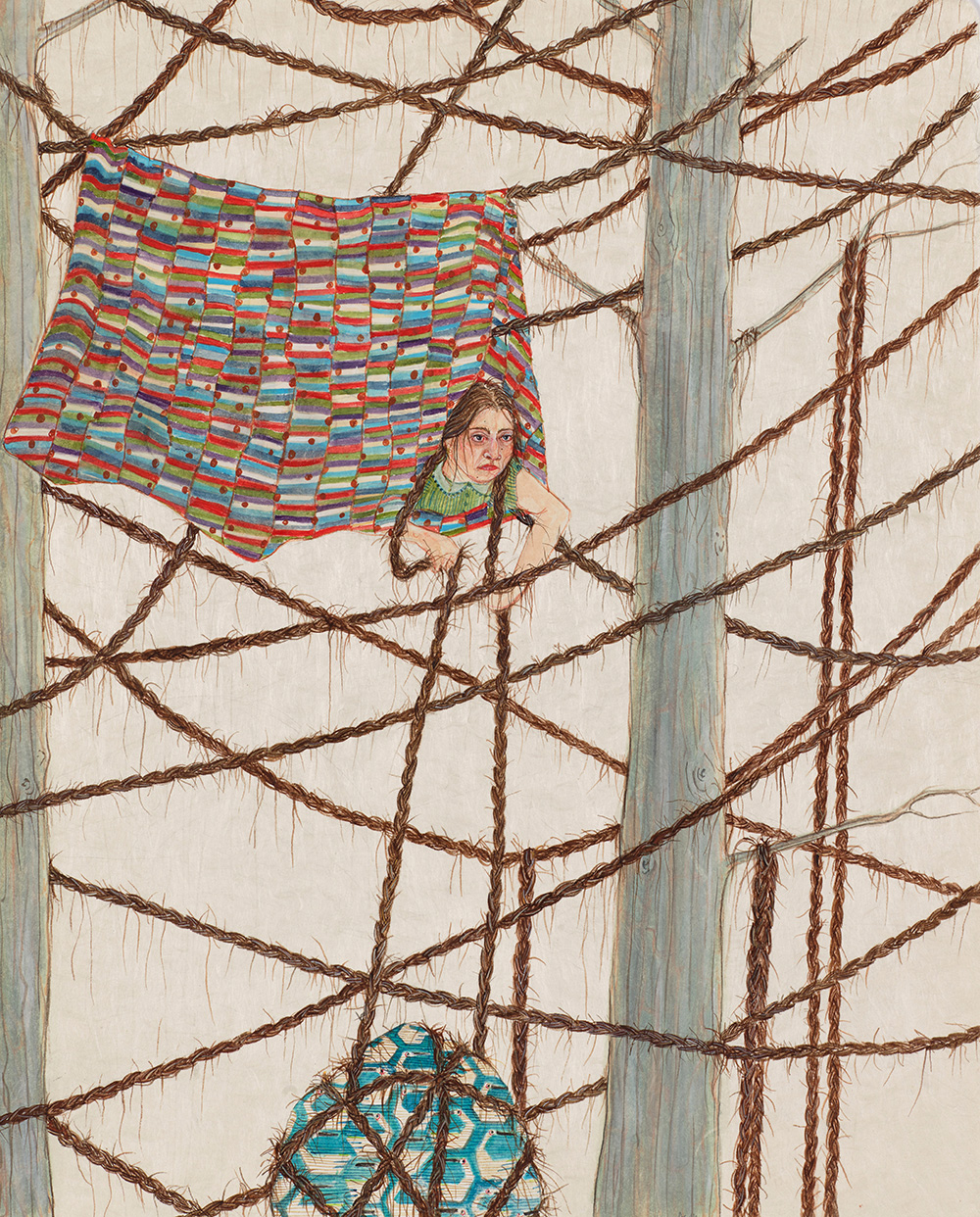
Let’s talk about your plastic animals.
I have an extensive collection. I use them as my models. Sometimes I need a quick reference on the mechanics of how their body might move. It’s ideal to be able to hold it your hand and explore different angles.
Has motherhood become a topic in your work since you began that experience?
It has slowly entered. Remedy is about my inability to breastfeed after an emergency c-section. It was quite a journey. Random people were quick to offer advice and warned me about the demise of my son’s well being. In the painting, the breasts hang like pendulums from the arrows that pierce their chests. This is a nod to Amazonian warriors who were said to have cut off their right breast to have better bow control. Three women on stilts line up to prescribe their remedies.
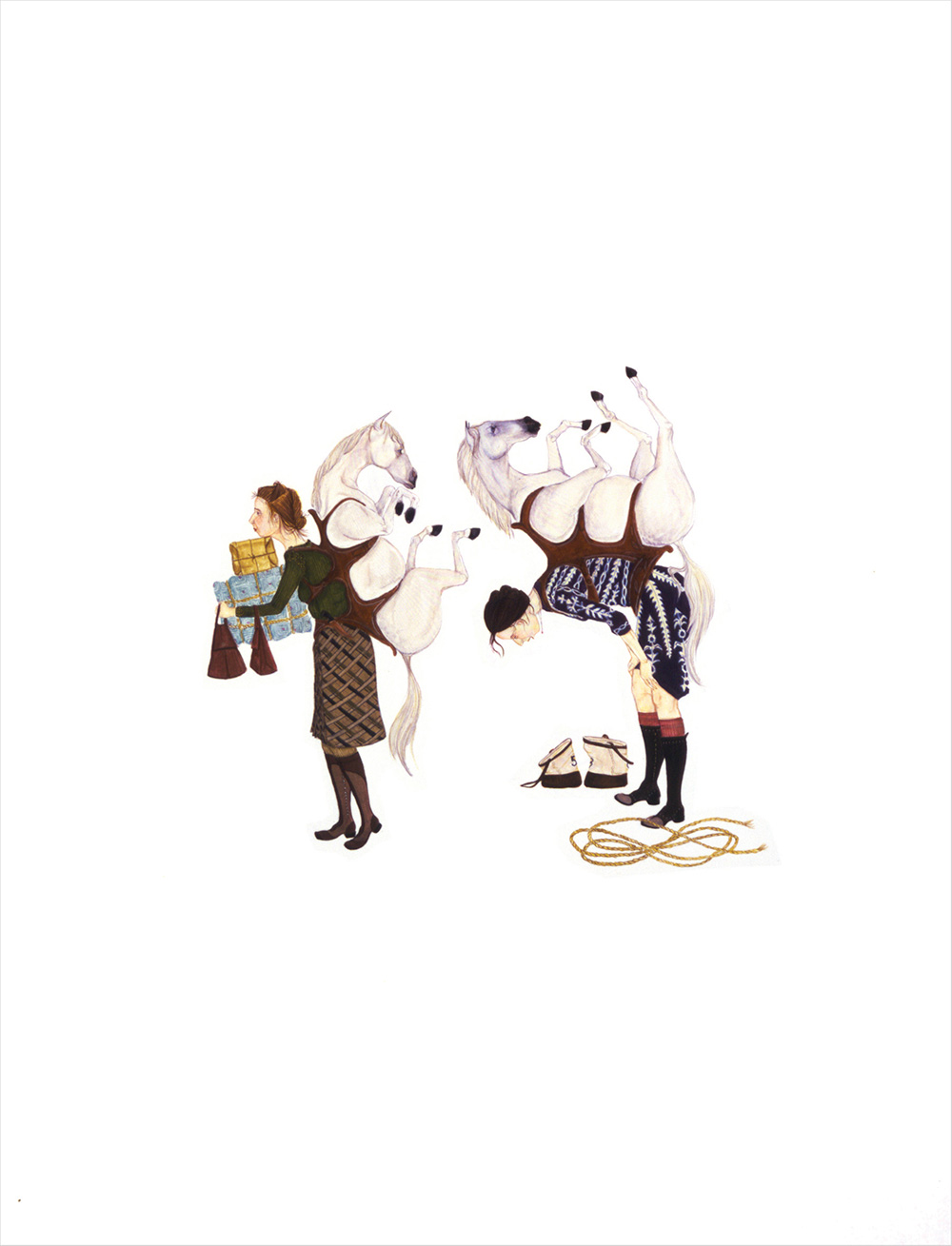
It’s a very disorientating time. I’m only five years into motherhood, so I’m sure there is more to come. I have sketches that explore my cesarean delivery experience, but they haven’t made their way into a painting. I remember the doctor saying, “You will now feel like you are being stepped on by an elephant,” as a way to prepare me for the sensation of my son being born. I was not expecting that kind of prompt and am happy to report it felt nothing like that, but the anticipation was great.
You paint women, and the current American administration has a painfully antiquated view on our rights. Has this climate had an effect on your work yet?
I think my current investigations into numbness and volatility via opium dens and apocalyptic landscapes seem well-suited for the current climate.
*
See new work from Amy Cutler at the 20th Anniversary show for Leslie Tonkonow Artworks + Projects through August 11th, 2017.
http://www.tonkonow.com/





